Nursing Assignment: Analyzing Therapeutic Relationships and Barriers
VerifiedAdded on 2022/11/23
|6
|1412
|335
Essay
AI Summary
This nursing assignment explores the challenges and barriers encountered by registered nurses in establishing therapeutic and professional relationships with patients. Using the Australian Nursing Standards Assessment Tool (ANSAT) and the Gibbs reflective cycle, the essay reflects on a personal experience with an elderly patient suffering from dementia and depression, highlighting issues such as language barriers, cultural differences, and physical discomfort. The analysis identifies these barriers and discusses their impact on patient care, concluding with an action plan to improve communication skills and address potential challenges in future patient interactions. The assignment emphasizes the importance of therapeutic relationships in providing quality patient care and offers strategies for overcoming obstacles to effective communication and support.
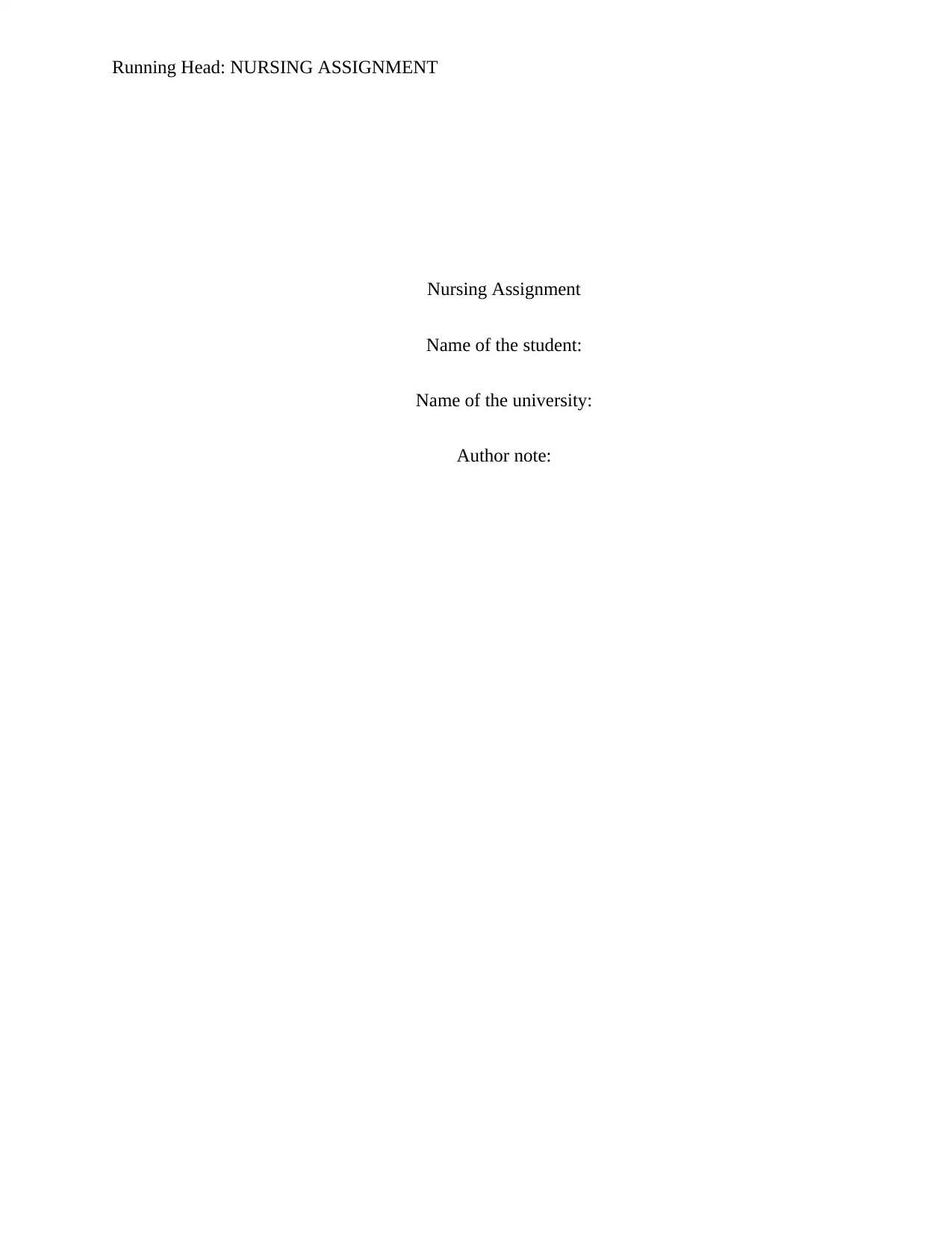
Running Head: NURSING ASSIGNMENT
Nursing Assignment
Name of the student:
Name of the university:
Author note:
Nursing Assignment
Name of the student:
Name of the university:
Author note:
Paraphrase This Document
Need a fresh take? Get an instant paraphrase of this document with our AI Paraphraser
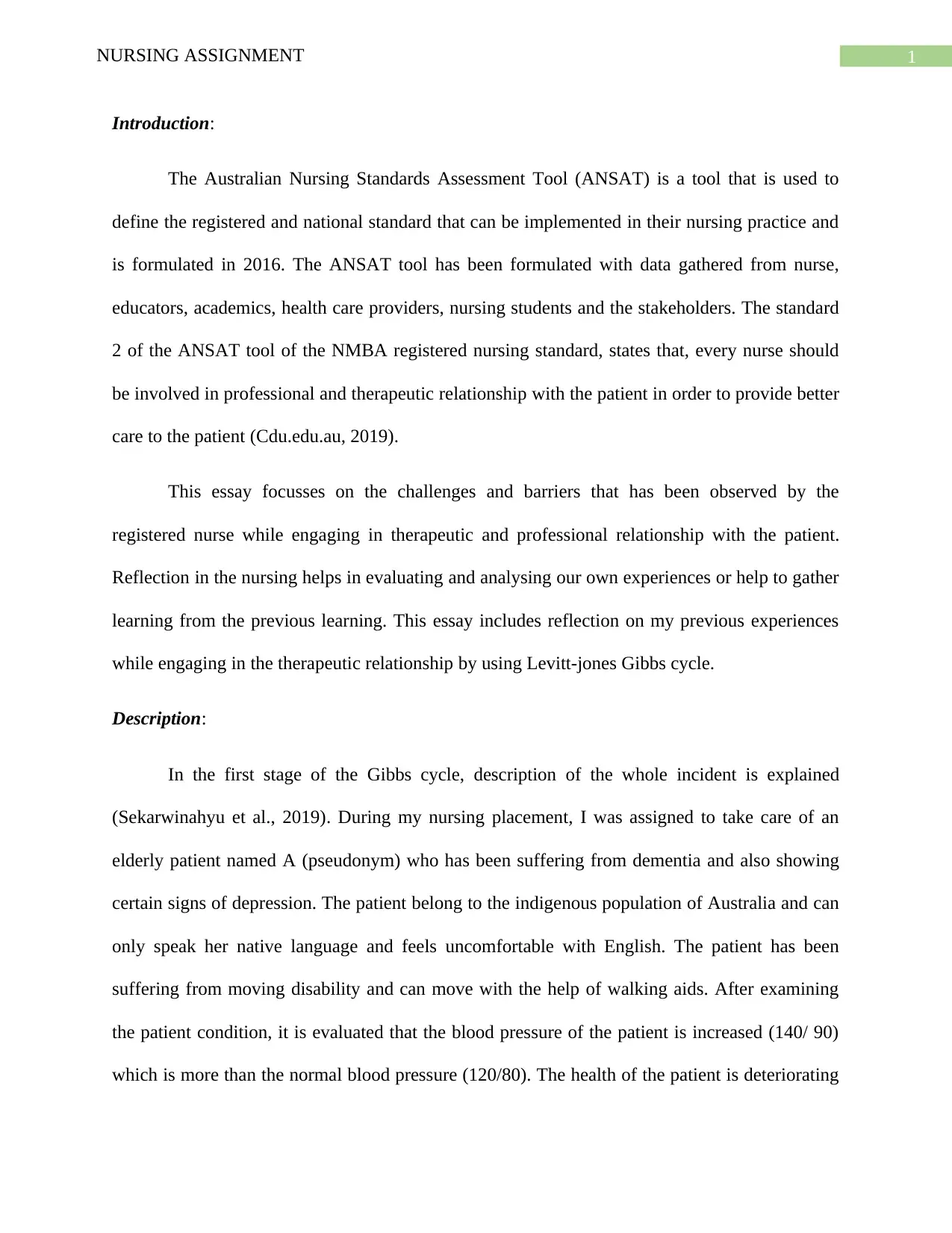
1NURSING ASSIGNMENT
Introduction:
The Australian Nursing Standards Assessment Tool (ANSAT) is a tool that is used to
define the registered and national standard that can be implemented in their nursing practice and
is formulated in 2016. The ANSAT tool has been formulated with data gathered from nurse,
educators, academics, health care providers, nursing students and the stakeholders. The standard
2 of the ANSAT tool of the NMBA registered nursing standard, states that, every nurse should
be involved in professional and therapeutic relationship with the patient in order to provide better
care to the patient (Cdu.edu.au, 2019).
This essay focusses on the challenges and barriers that has been observed by the
registered nurse while engaging in therapeutic and professional relationship with the patient.
Reflection in the nursing helps in evaluating and analysing our own experiences or help to gather
learning from the previous learning. This essay includes reflection on my previous experiences
while engaging in the therapeutic relationship by using Levitt-jones Gibbs cycle.
Description:
In the first stage of the Gibbs cycle, description of the whole incident is explained
(Sekarwinahyu et al., 2019). During my nursing placement, I was assigned to take care of an
elderly patient named A (pseudonym) who has been suffering from dementia and also showing
certain signs of depression. The patient belong to the indigenous population of Australia and can
only speak her native language and feels uncomfortable with English. The patient has been
suffering from moving disability and can move with the help of walking aids. After examining
the patient condition, it is evaluated that the blood pressure of the patient is increased (140/ 90)
which is more than the normal blood pressure (120/80). The health of the patient is deteriorating
Introduction:
The Australian Nursing Standards Assessment Tool (ANSAT) is a tool that is used to
define the registered and national standard that can be implemented in their nursing practice and
is formulated in 2016. The ANSAT tool has been formulated with data gathered from nurse,
educators, academics, health care providers, nursing students and the stakeholders. The standard
2 of the ANSAT tool of the NMBA registered nursing standard, states that, every nurse should
be involved in professional and therapeutic relationship with the patient in order to provide better
care to the patient (Cdu.edu.au, 2019).
This essay focusses on the challenges and barriers that has been observed by the
registered nurse while engaging in therapeutic and professional relationship with the patient.
Reflection in the nursing helps in evaluating and analysing our own experiences or help to gather
learning from the previous learning. This essay includes reflection on my previous experiences
while engaging in the therapeutic relationship by using Levitt-jones Gibbs cycle.
Description:
In the first stage of the Gibbs cycle, description of the whole incident is explained
(Sekarwinahyu et al., 2019). During my nursing placement, I was assigned to take care of an
elderly patient named A (pseudonym) who has been suffering from dementia and also showing
certain signs of depression. The patient belong to the indigenous population of Australia and can
only speak her native language and feels uncomfortable with English. The patient has been
suffering from moving disability and can move with the help of walking aids. After examining
the patient condition, it is evaluated that the blood pressure of the patient is increased (140/ 90)
which is more than the normal blood pressure (120/80). The health of the patient is deteriorating
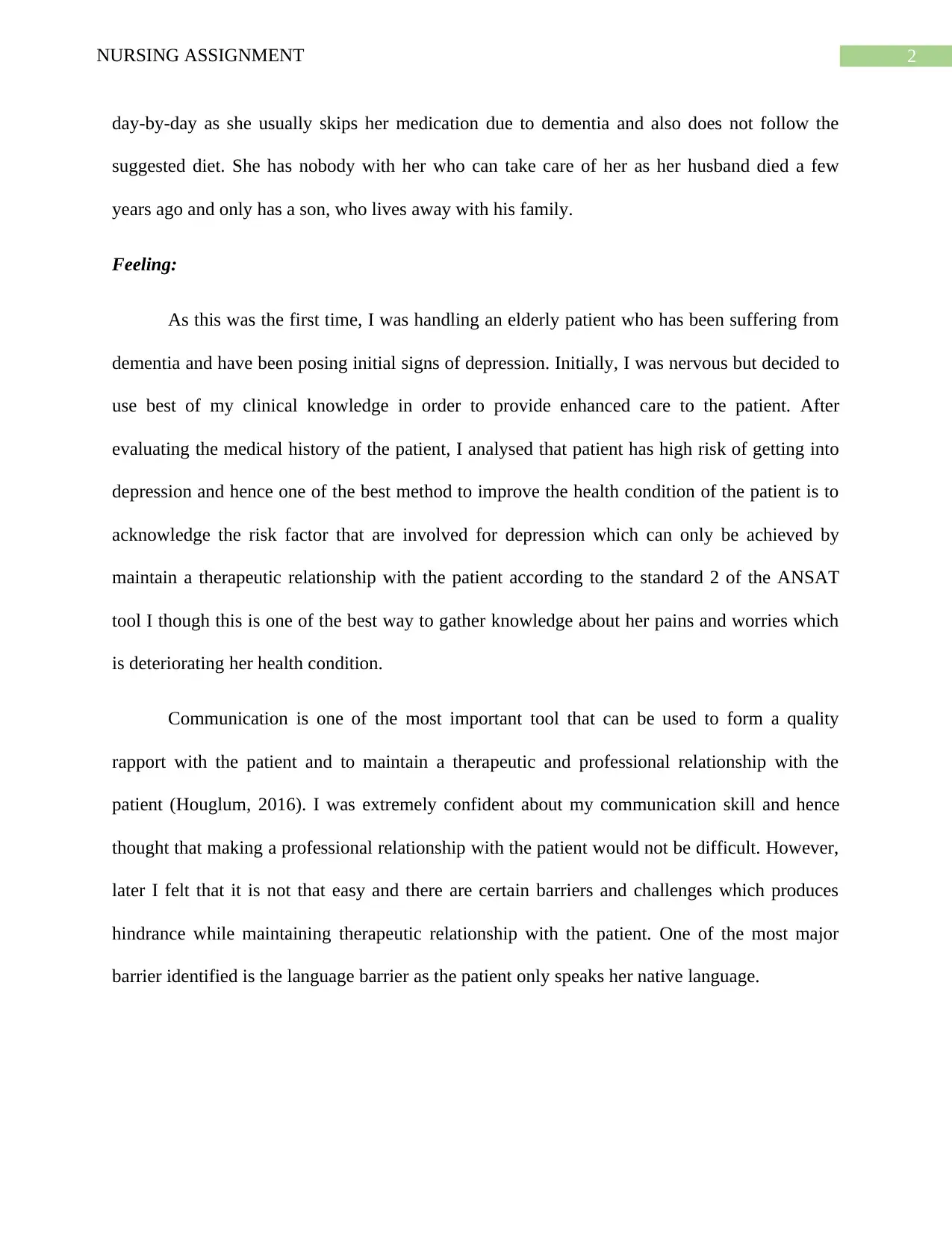
2NURSING ASSIGNMENT
day-by-day as she usually skips her medication due to dementia and also does not follow the
suggested diet. She has nobody with her who can take care of her as her husband died a few
years ago and only has a son, who lives away with his family.
Feeling:
As this was the first time, I was handling an elderly patient who has been suffering from
dementia and have been posing initial signs of depression. Initially, I was nervous but decided to
use best of my clinical knowledge in order to provide enhanced care to the patient. After
evaluating the medical history of the patient, I analysed that patient has high risk of getting into
depression and hence one of the best method to improve the health condition of the patient is to
acknowledge the risk factor that are involved for depression which can only be achieved by
maintain a therapeutic relationship with the patient according to the standard 2 of the ANSAT
tool I though this is one of the best way to gather knowledge about her pains and worries which
is deteriorating her health condition.
Communication is one of the most important tool that can be used to form a quality
rapport with the patient and to maintain a therapeutic and professional relationship with the
patient (Houglum, 2016). I was extremely confident about my communication skill and hence
thought that making a professional relationship with the patient would not be difficult. However,
later I felt that it is not that easy and there are certain barriers and challenges which produces
hindrance while maintaining therapeutic relationship with the patient. One of the most major
barrier identified is the language barrier as the patient only speaks her native language.
day-by-day as she usually skips her medication due to dementia and also does not follow the
suggested diet. She has nobody with her who can take care of her as her husband died a few
years ago and only has a son, who lives away with his family.
Feeling:
As this was the first time, I was handling an elderly patient who has been suffering from
dementia and have been posing initial signs of depression. Initially, I was nervous but decided to
use best of my clinical knowledge in order to provide enhanced care to the patient. After
evaluating the medical history of the patient, I analysed that patient has high risk of getting into
depression and hence one of the best method to improve the health condition of the patient is to
acknowledge the risk factor that are involved for depression which can only be achieved by
maintain a therapeutic relationship with the patient according to the standard 2 of the ANSAT
tool I though this is one of the best way to gather knowledge about her pains and worries which
is deteriorating her health condition.
Communication is one of the most important tool that can be used to form a quality
rapport with the patient and to maintain a therapeutic and professional relationship with the
patient (Houglum, 2016). I was extremely confident about my communication skill and hence
thought that making a professional relationship with the patient would not be difficult. However,
later I felt that it is not that easy and there are certain barriers and challenges which produces
hindrance while maintaining therapeutic relationship with the patient. One of the most major
barrier identified is the language barrier as the patient only speaks her native language.
⊘ This is a preview!⊘
Do you want full access?
Subscribe today to unlock all pages.

Trusted by 1+ million students worldwide
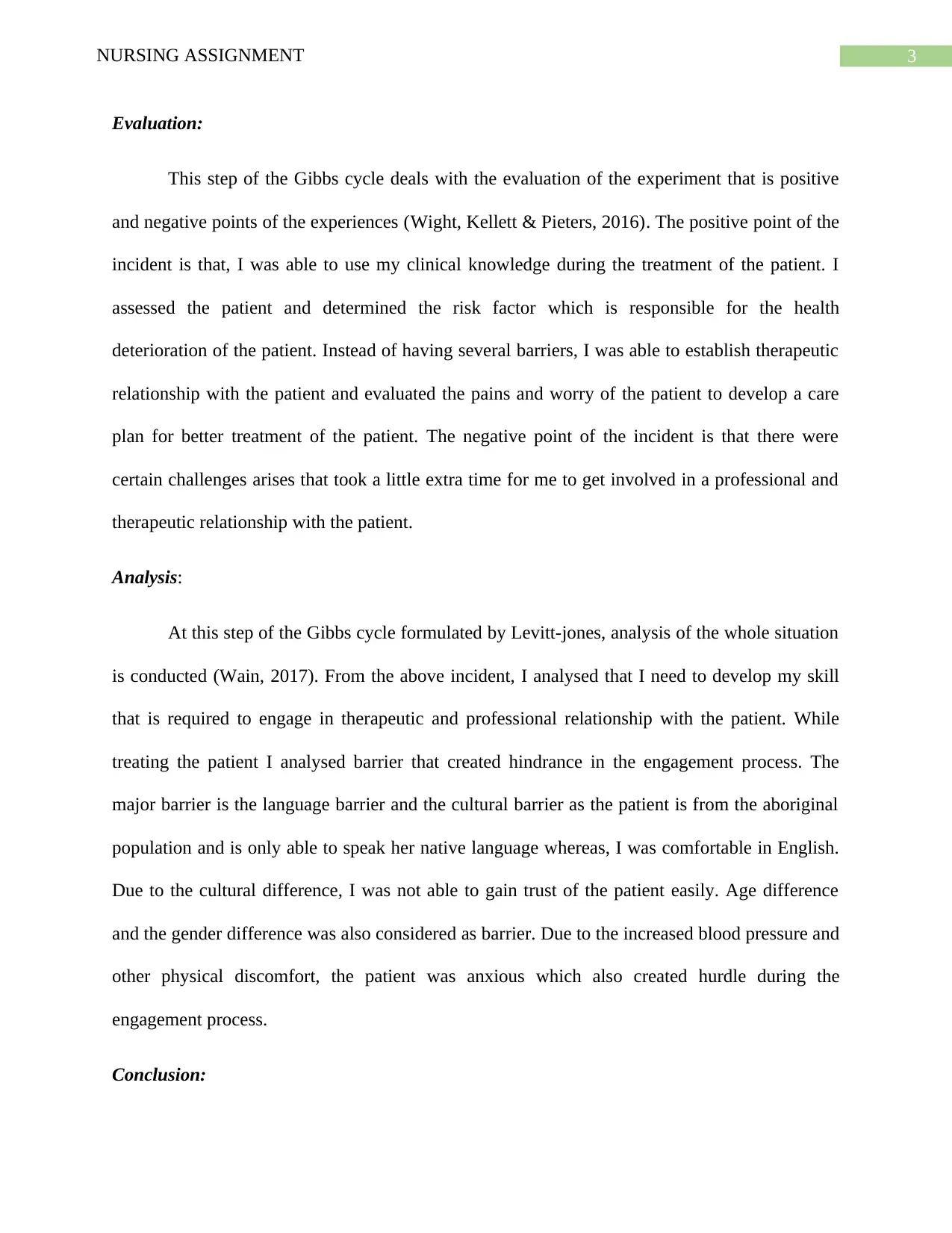
3NURSING ASSIGNMENT
Evaluation:
This step of the Gibbs cycle deals with the evaluation of the experiment that is positive
and negative points of the experiences (Wight, Kellett & Pieters, 2016). The positive point of the
incident is that, I was able to use my clinical knowledge during the treatment of the patient. I
assessed the patient and determined the risk factor which is responsible for the health
deterioration of the patient. Instead of having several barriers, I was able to establish therapeutic
relationship with the patient and evaluated the pains and worry of the patient to develop a care
plan for better treatment of the patient. The negative point of the incident is that there were
certain challenges arises that took a little extra time for me to get involved in a professional and
therapeutic relationship with the patient.
Analysis:
At this step of the Gibbs cycle formulated by Levitt-jones, analysis of the whole situation
is conducted (Wain, 2017). From the above incident, I analysed that I need to develop my skill
that is required to engage in therapeutic and professional relationship with the patient. While
treating the patient I analysed barrier that created hindrance in the engagement process. The
major barrier is the language barrier and the cultural barrier as the patient is from the aboriginal
population and is only able to speak her native language whereas, I was comfortable in English.
Due to the cultural difference, I was not able to gain trust of the patient easily. Age difference
and the gender difference was also considered as barrier. Due to the increased blood pressure and
other physical discomfort, the patient was anxious which also created hurdle during the
engagement process.
Conclusion:
Evaluation:
This step of the Gibbs cycle deals with the evaluation of the experiment that is positive
and negative points of the experiences (Wight, Kellett & Pieters, 2016). The positive point of the
incident is that, I was able to use my clinical knowledge during the treatment of the patient. I
assessed the patient and determined the risk factor which is responsible for the health
deterioration of the patient. Instead of having several barriers, I was able to establish therapeutic
relationship with the patient and evaluated the pains and worry of the patient to develop a care
plan for better treatment of the patient. The negative point of the incident is that there were
certain challenges arises that took a little extra time for me to get involved in a professional and
therapeutic relationship with the patient.
Analysis:
At this step of the Gibbs cycle formulated by Levitt-jones, analysis of the whole situation
is conducted (Wain, 2017). From the above incident, I analysed that I need to develop my skill
that is required to engage in therapeutic and professional relationship with the patient. While
treating the patient I analysed barrier that created hindrance in the engagement process. The
major barrier is the language barrier and the cultural barrier as the patient is from the aboriginal
population and is only able to speak her native language whereas, I was comfortable in English.
Due to the cultural difference, I was not able to gain trust of the patient easily. Age difference
and the gender difference was also considered as barrier. Due to the increased blood pressure and
other physical discomfort, the patient was anxious which also created hurdle during the
engagement process.
Conclusion:
Paraphrase This Document
Need a fresh take? Get an instant paraphrase of this document with our AI Paraphraser
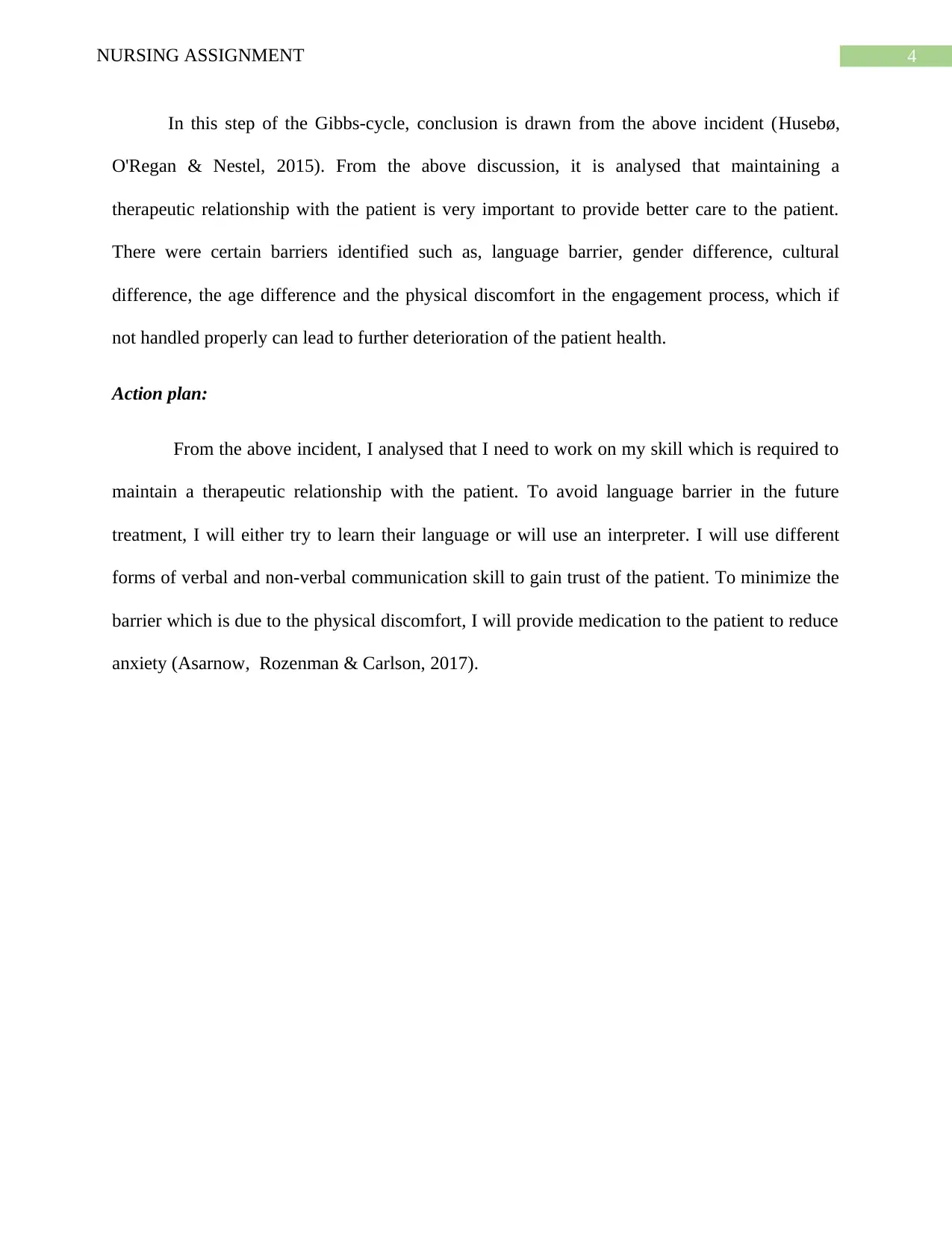
4NURSING ASSIGNMENT
In this step of the Gibbs-cycle, conclusion is drawn from the above incident (Husebø,
O'Regan & Nestel, 2015). From the above discussion, it is analysed that maintaining a
therapeutic relationship with the patient is very important to provide better care to the patient.
There were certain barriers identified such as, language barrier, gender difference, cultural
difference, the age difference and the physical discomfort in the engagement process, which if
not handled properly can lead to further deterioration of the patient health.
Action plan:
From the above incident, I analysed that I need to work on my skill which is required to
maintain a therapeutic relationship with the patient. To avoid language barrier in the future
treatment, I will either try to learn their language or will use an interpreter. I will use different
forms of verbal and non-verbal communication skill to gain trust of the patient. To minimize the
barrier which is due to the physical discomfort, I will provide medication to the patient to reduce
anxiety (Asarnow, Rozenman & Carlson, 2017).
In this step of the Gibbs-cycle, conclusion is drawn from the above incident (Husebø,
O'Regan & Nestel, 2015). From the above discussion, it is analysed that maintaining a
therapeutic relationship with the patient is very important to provide better care to the patient.
There were certain barriers identified such as, language barrier, gender difference, cultural
difference, the age difference and the physical discomfort in the engagement process, which if
not handled properly can lead to further deterioration of the patient health.
Action plan:
From the above incident, I analysed that I need to work on my skill which is required to
maintain a therapeutic relationship with the patient. To avoid language barrier in the future
treatment, I will either try to learn their language or will use an interpreter. I will use different
forms of verbal and non-verbal communication skill to gain trust of the patient. To minimize the
barrier which is due to the physical discomfort, I will provide medication to the patient to reduce
anxiety (Asarnow, Rozenman & Carlson, 2017).
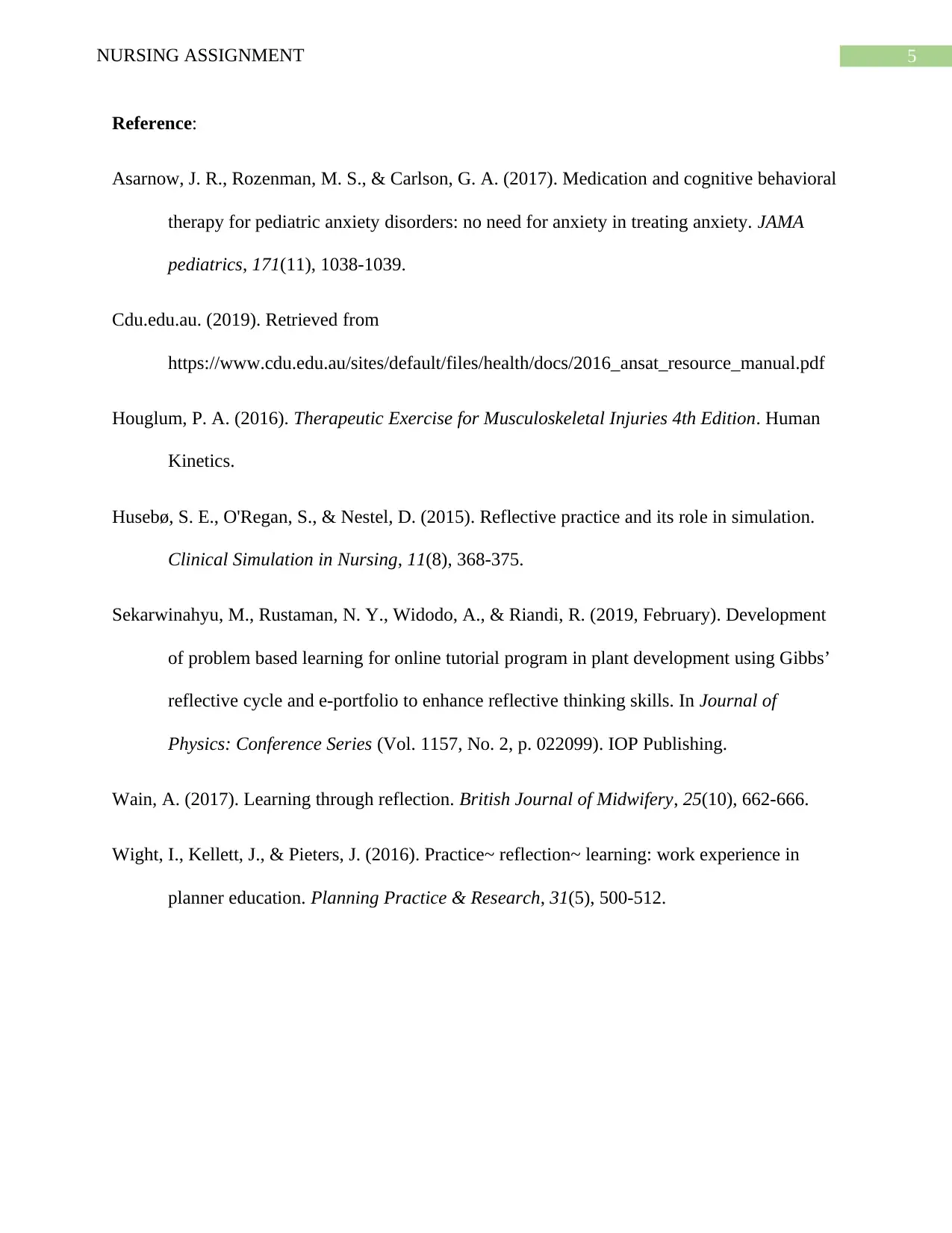
5NURSING ASSIGNMENT
Reference:
Asarnow, J. R., Rozenman, M. S., & Carlson, G. A. (2017). Medication and cognitive behavioral
therapy for pediatric anxiety disorders: no need for anxiety in treating anxiety. JAMA
pediatrics, 171(11), 1038-1039.
Cdu.edu.au. (2019). Retrieved from
https://www.cdu.edu.au/sites/default/files/health/docs/2016_ansat_resource_manual.pdf
Houglum, P. A. (2016). Therapeutic Exercise for Musculoskeletal Injuries 4th Edition. Human
Kinetics.
Husebø, S. E., O'Regan, S., & Nestel, D. (2015). Reflective practice and its role in simulation.
Clinical Simulation in Nursing, 11(8), 368-375.
Sekarwinahyu, M., Rustaman, N. Y., Widodo, A., & Riandi, R. (2019, February). Development
of problem based learning for online tutorial program in plant development using Gibbs’
reflective cycle and e-portfolio to enhance reflective thinking skills. In Journal of
Physics: Conference Series (Vol. 1157, No. 2, p. 022099). IOP Publishing.
Wain, A. (2017). Learning through reflection. British Journal of Midwifery, 25(10), 662-666.
Wight, I., Kellett, J., & Pieters, J. (2016). Practice~ reflection~ learning: work experience in
planner education. Planning Practice & Research, 31(5), 500-512.
Reference:
Asarnow, J. R., Rozenman, M. S., & Carlson, G. A. (2017). Medication and cognitive behavioral
therapy for pediatric anxiety disorders: no need for anxiety in treating anxiety. JAMA
pediatrics, 171(11), 1038-1039.
Cdu.edu.au. (2019). Retrieved from
https://www.cdu.edu.au/sites/default/files/health/docs/2016_ansat_resource_manual.pdf
Houglum, P. A. (2016). Therapeutic Exercise for Musculoskeletal Injuries 4th Edition. Human
Kinetics.
Husebø, S. E., O'Regan, S., & Nestel, D. (2015). Reflective practice and its role in simulation.
Clinical Simulation in Nursing, 11(8), 368-375.
Sekarwinahyu, M., Rustaman, N. Y., Widodo, A., & Riandi, R. (2019, February). Development
of problem based learning for online tutorial program in plant development using Gibbs’
reflective cycle and e-portfolio to enhance reflective thinking skills. In Journal of
Physics: Conference Series (Vol. 1157, No. 2, p. 022099). IOP Publishing.
Wain, A. (2017). Learning through reflection. British Journal of Midwifery, 25(10), 662-666.
Wight, I., Kellett, J., & Pieters, J. (2016). Practice~ reflection~ learning: work experience in
planner education. Planning Practice & Research, 31(5), 500-512.
⊘ This is a preview!⊘
Do you want full access?
Subscribe today to unlock all pages.

Trusted by 1+ million students worldwide
1 out of 6
Related Documents
Your All-in-One AI-Powered Toolkit for Academic Success.
+13062052269
info@desklib.com
Available 24*7 on WhatsApp / Email
![[object Object]](/_next/static/media/star-bottom.7253800d.svg)
Unlock your academic potential
Copyright © 2020–2025 A2Z Services. All Rights Reserved. Developed and managed by ZUCOL.





